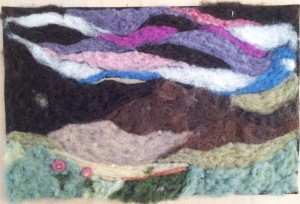I recently attended a talk by psychologist Susan Daniels, who lectures and writes about creativity. Her talk was based on a book she’d read, assigned to her college students, and followed herself. (The book, which she highly recommends, is The Creativity Cure by Carrie and Alton Barron. Susan’s book is Raising Creative Kids and I reviewed it here.)
Susan’s talk was about the importance of “everyday creativity” for everyone. Although some of us are involved in creative work for pay, and others of us think of ourselves as “not creative,” we all benefit from using our hands and bodies to do what’s called “little-c creativity.” This is the sort of creativity involved in improvising a new dish while cooking, playing a song on the piano, or making up a game with our kids. It’s pretty humble stuff—not meant to impress anyone else, done for enjoyment and only sometimes with a product that we use or enjoy.

Susan suggests that we can all improve our well-being by not only pursuing little-c creativity, but incorporating it into our lives with intention. In her own life, despite her busy life as a psychologist, teacher, and lecturer, she intentionally returned to painting, which she had enjoyed when she was younger. This is not a career move for her. Although her photos showed that the results of her endeavor could certainly be called successful art, she’s not suggesting that we all drop our day jobs and become professional artists.
Instead, she’s suggesting that we can improve our lives by taking on tasks that we do with our hands only for the pleasure of doing them.
Susan’s talk reminded me of a huge change that I underwent when I started homeschooling. Although I’d done many projects at home with my children when they were little, it wasn’t until we were homeschooling that I initiated and took part in art projects that fed my own creativity as well as my children’s. My daughter loves videos by Vi Hart—Vi’s mathematical approach to art really inspires her. So for a while my kids and I were making scribble drawings and binary trees. Inspired by that, I bought Geometric Graphics, a wonderful book from Key Curriculum Press about mathematically based art, and we completed many projects in that book.
We also had more time for intentional art projects such as collaging gifts, decorating household items to send to their grandmother, making videos based on what they were learning (or just sheer silliness), and lots of creative cooking. We went to workshops run by other homeschoolers and did weaving, painting, sculpting, and other handwork that we would probably never have attempted on our own.
All the while I was thinking that these activities were for the children, but it often occurred to me that I enjoyed them even more. It’s not uncommon when homeschoolers get together to do a project with a group of younger children that the children finish their projects quickly and run off to play, while the moms sit for much longer, chatting together but also applying a lot more effort to their artwork than is necessary to model creative play to children. Clearly, we all felt the joy of incorporating that little-c creativity into our lives.
It occurs to me that this is one part of my life that has changed pretty dramatically for two reasons. One is that my younger and more artistically hands-on child has gone off to school. Although we still do projects together, our output is nowhere near what it was before. The other is that my older child, never strongly attracted to the physical arts, got to the age that he largely pursues his own creative projects, which are mostly independent of me and usually done on computers.
I was ready to feel bad about this as I sat listening to Susan’s talk, but then as I thought back on my year, I realized that after an initial slump of little-c creative activity, I have since started pursuing more independent activities. (Since my work is creative I pretty much daily partake in Big-C creativity, but not in the hands-on, personally fulfilling creative projects that Susan was encouraging.) This year, with some time freed up from homeschooling, I started to play guitar after many years of letting it slide. A friend and I made a list of songs that we started to learn and sing together. After pretty much ignoring what was on our walls and displayed on shelves for years, I have gone on a frenzy of home aesthetic improvement, a little-c creative project if ever I’ve seen one.
I haven’t read The Creativity Cure yet, but based on my own experience I encourage everyone to take a look at their lives and consider whether they are pursuing a healthy amount of little-c creativity on a daily basis. In our professionalized culture, we often feel bad about being an amateur at something that other people are compensated for. Especially in pursuits that can be highly rewarded in our culture, such as popular singing, I often hear people say, “Oh, I’m no good at that so you don’t want to hear me.” Well, heck, people might not want to hear me sing or see my artwork, but I’m going to do it anyway. Susan and my homeschooling role models taught me well that little-c creativity looms large in its ability to make life enjoyable and fulfilling.